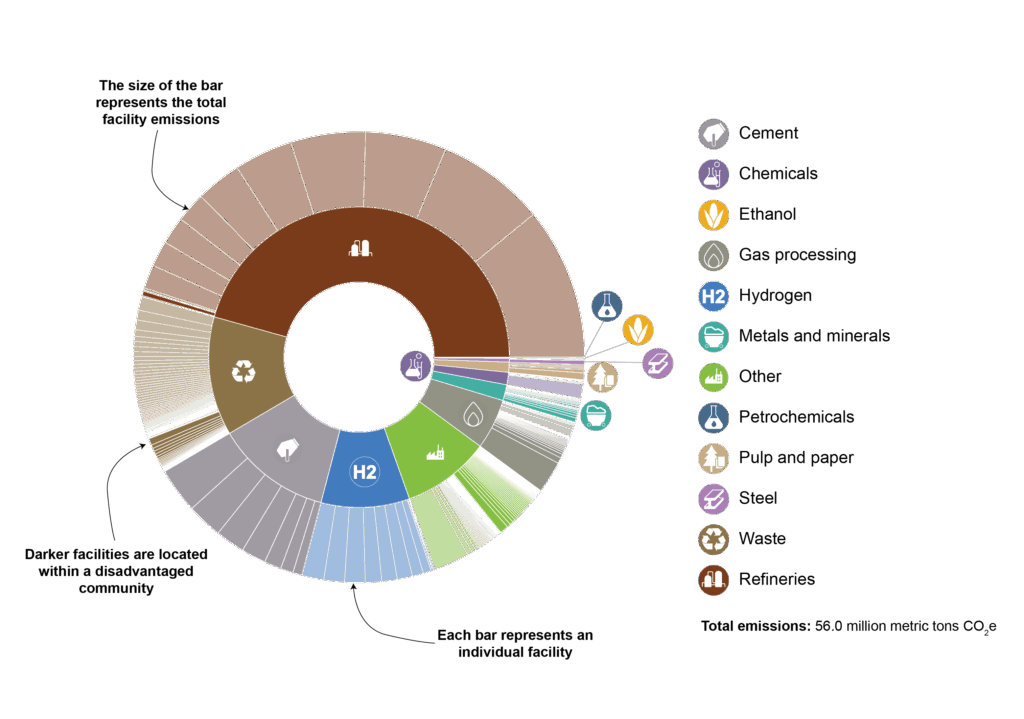California
California ranks third in the nation in industrial emissions. The state’s sixteen refineries account for thirty-seven percent of industrial emissions. Other high-emitting sectors include petroleum and gas systems, non-fluorinated chemicals, and minerals. Hydrogen production generates virtually all the emissions in the chemical sector. Cement production is responsible for nearly 90 percent of emissions from the minerals sector. Industry is clustered in the Bay Area, southern California, and the Central Valley.

- The top 20 emitters are shown on this map, coded by industrial sector. The size of the circles corresponds to emissions: the larger the circle, the higher the emissions.
- Disadvantaged communities (as determined by the federal government) are shaded blue.

- The inner circle provides a visual representation of the share of emissions generated by each industrial sector.
- The outer circle also indicates the share of a sector’s emissions generated in disadvantaged communities.
State Energy Policy:
Examining a state’s broader energy policy landscape is helpful when considering policies to support industrial innovation. California has established statutory and executive greenhouse gas emissions targets and a renewable portfolio standard. California has not established a clean heat standard. While these formal commitments are not prerequisites for innovative industrial policy, they can provide a supportive framework. In addition, streamlining permitting and establishing an efficient, transparent appeals process that engages local communities early while giving clarity and assurances to project developers are key components of effective state energy policy. Discussions around innovative industrial policy present an opportunity for broader conversations about state energy policy to ensure a mutually reinforcing strategy.
LEGISLATIVE context & opportunity:
Let us know if you are aware of additional legislation advancing industrial innovation in California that should be highlighted. The context below is not exhaustive and serves as an example of recent policies and programs and where there may be future opportunities:
- Buy Clean California Act: California was the first state to pass a Buy Clean policy in 2017 with A.B. 262, which set maximum emissions limits for four eligible materials: structural steel, concrete reinforcing steel, flat glass, and insulation. After several years of gathering data, emissions standards went into effect in 2022.
- Alliance for Renewable Clean Hydrogen Energy Systems (ARCHES): California is the sole state in the ARCHES Regional Clean Hydrogen Hub. Independent of the outcome of the regional hubs, there is strong interest in building a clean hydrogen economy in the state given California’s size, diverse geography and economy, and history as a leader in clean energy innovation and policy.
- Industrial Decarbonization and Improvement of Grid Infrastructure (INDIGO): INDIGO was established in 2021 by A.B. 209 to incentivize industrial projects that benefit the electrical grid, reduce emissions, and improve air quality. Eligible projects include enhancing grid reliability, electrifying processes, incorporating energy storage or renewable resources, increasing energy efficiency, and developing and deploying novel technologies and strategies that reduce emissions.
- A factsheet by the Renewable Thermal Collaborative identifies electrification of California’s container glass, beer, and pulp and paper subsectors as opportunities to reduce emissions significantly.
California has enacted and considered a range of legislation that supports industrial innovation, including carbon capture, clean hydrogen, and procurement. Explore recent legislation in California and all 50 states by clicking on a specific year: 2025 legislation, 2024 legislation, 2023 legislation.
